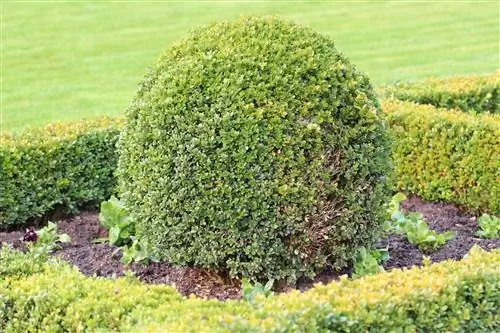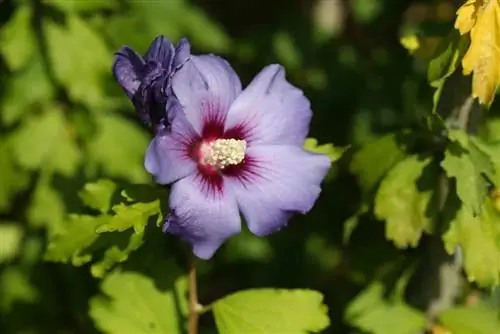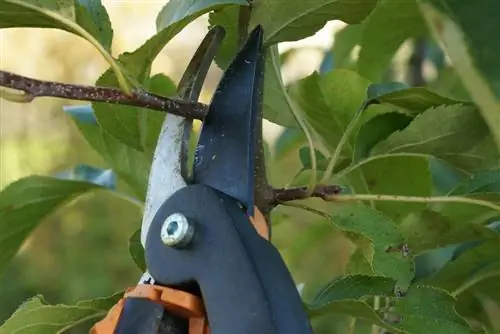- Author admin [email protected].
- Public 2023-12-17 03:39.
- Last modified 2025-01-24 12:45.
Cheating is not only permitted in this case, but encouraged: ball maple, columnar juniper, etc. simulate high pruning skills. Do you think your garden is still missing something? Something that underlines the formal character or gives support to the lush, colorful flowering perennial beds and soothes the eye?
Your first thought: bushes and trees cut into geometric shapes. If only it weren't for the annoying cutting, do you think? This excuse doesn't apply! There are plants that grow into the right shape on their own in the first few years: into balls, cones or columns. You only have to sharpen the scissors if you really want a square.
Topiaries for garden design
The big advantage of these trees: With their compact growth, they not only fit in the smallest garden, but also suit any garden style. The effect of the plants depends on their shape:
- Balls are considered eye-catchers. They blend in particularly well with stairs and walls or between naturally growing perennials.
- Columnar, vertical trees appear closer to us than horizontal ones and therefore visually make a garden smaller.
- Individually they represent a striking point in the garden, planted in a row they point a direction or form green walls.
- Both forms look impressive between ground-covering plants. Trees and shrubs form the framework of a garden, especially evergreens, which look the same all year round.
The situation is completely different with many deciduous shrubs: they bloom, produce fruit and later lose their leaves. However, the branches still retain the topiary effect. In general, spring and fall are considered planting times for deciduous shrubs. Potted products can be used all year round, except when there is frost. Evergreen deciduous trees and conifers are planted in April or September. In branded nurseries you can get advice and be confident that you are getting the right varieties.
Figure-shaped trees
Hardly anyone can resist the engaging and versatile nature of a boxwood. In rural areas you can sometimes still see it leaning against the garden fence: a large, old box tree (Buxus sempervirens). Its branches are still used today to make traditional tufts or wreaths. It is much more common to see the shrub cut into shape, which it is ideal for as it keeps sprouting.
Due to their slow growth, the figures last quite a long time. Unfortunately, hardly anyone has the patience to grow tall box hedges. It's a shame, because they are many times more beautiful and dense than hornbeam, privet or thuja. What many people don't know: There are around 60 different varieties of boxwood, but only around a dozen of them are commercially available. They are all evergreen, but not every variety is suitable for every purpose. For the border hedges that are typical in cottage gardens, which make the beds look neat and the colorful flowers shine even more, you don't choose a variety that grows into a huge solitary tree. Box prefers calcareous, warm and dry soil, but tolerates almost all locations.
The best trees for a topiary
When it comes to really impressive topiaries, every well-read gardener immediately thinks of the boxwood, of which he has been able to see wonderful images of topiaries, some of which are centuries old. Almost every country that has developed a park culture has also cut boxwoods into topiaries; they seem to be extremely well suited to topiary. In fact, the boxwood has an advantage that makes it ideal for topiary: fairly small and quite close together leaves, which make each shape visible even with small plant volumes (imagine you should have an American linden tree with 25 cm Cut large leaves into a recognizable shape, which would then have to be quite large before you can see clear outlines).
Box trees
Box trees are the first choice if you want to have a complicated figure in your garden at some point, and you can also choose from these box trees: There are many types of box trees that are suitable for different topiary shapes. If you look for a tree nursery that deals in different types of boxwood, they will be able to tell you which type of boxwood is best suited to the figure you have in mind. The company of Dr. rer. medic. Jürgen W. H. Niebuhr from 71686 Remseck has specialized in boxwood topiaries. In addition to ready-cut shapes, you can also purchase numerous types of boxwood at www.buchsbaum.de.
Coniferous trees
Many coniferous trees would actually offer the advantage of boxwood to a greater extent because they produce needle leaves that are extraordinarily close together (yes, these are leaves too), but coniferous trees have a different, more serious one when it comes to topiary Disadvantage: They can only be pruned well in exceptional cases; spruces, firs, false cypresses and firs cannot be forced into a shape by cutting at all. Only the European yew can tolerate such intensive pruning that a shape can be created. Pines and junipers can also be pruned quite well, but here only figures that the natural growth habit already offers are conceivable.
If you don't have any greater demands on the form than the design of a simple straight (hedge) wall or a simple pyramid, you could use the natural growth forms of other conifers: Some false cypresses and some arborvitae varieties with columnar growth can be used When cutting hedges into straight, vertical walls, many arborvitae naturally grow conically and can be quickly cut into a neat pyramid.
Fruit trees
The next candidate for a topiary is the fruit tree; here too, the topiaries known as espalier fruit can look back on a tradition that has been perfected for centuries. That's why creating a trellis requires a lot of specialist knowledge, and the maintenance effort can be overwhelming for a working hobby gardener.
It is conceivable to grow a fruit tree as a topiary on a trellis if you follow the trend that has been observed for years to allow a somewhat freer growth and not to insist on the classic, strict shape. In the past, pears were most commonly grown on trellises, then apricots and peaches; today, for example, B. specially bred apple trees and other “pillar fruit trees” are offered, which are naturally intended to grow particularly narrow. However, these cultivations are not always intended to taste convincing. If you don't see the shape as closely, you could also try a normal fruit tree from a good nursery, which should then be planted in autumn so that it is well rooted next spring and you can start shaping.
Tips for pruning a topiary
Box trees need to be pruned very regularly so that they eventually form a beautiful shape, while at the same time they become increasingly dense in their foliage:
- TheTopiarytherefore starts with the small boxwood, and it will keep you busy for many years until the figure has reached an impressive size, because the boxwood grows at a rather leisurely pace. But the shapes that are created are all the more beautiful, and that's also the reason why you can't spend a lot of money on a finished box shape figure.
- TheMain cut of the boxwood takes place in March and then again in September, in the summer the shape is corrected again in between, cutting is always done when the sky is overcast so that the fresh cut surfaces are not damaged burn.
When creating any shape, the basic principle for topiary cutting of a tree will help you: You look at your desired plant, think about the direction in which the shape should develop, and simply regularly cut off any shoots that grow in the opposite direction. Any woody plant can be shaped using the above-mentioned reductions; frequent pruning (spring, autumn and in between) promotes compact growth and gradually allows the desired shape to become more and more apparent.






